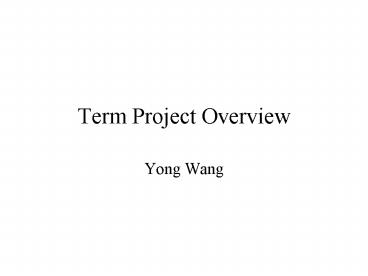Term Project Overview - PowerPoint PPT Presentation
Title:
Term Project Overview
Description:
ByteBlasterMV parallel port download cable. Project Overview ... Instruction memory (# of inst * avg. instr. length) data memory. immediate field ... – PowerPoint PPT presentation
Number of Views:22
Avg rating:3.0/5.0
Title: Term Project Overview
1
Term Project Overview
- Yong Wang
2
Introduction
- Goal
- familiarize with the design and implementation of
a simple pipelined RISC processor - What to do
- Build a processor from scratch (single-cycle
implementation) - Add some functions
- Pipeline datapath, pipeline control, hazard
detection unit, forwarding unit, branch hazard
handling unit - Write an assembler that detects data hazard and
optimizes the code to minimize stalls
3
Project Assignment
- Team-based work
- 4 to 5 Team members
- Task assignment for reference
- 2-3 ISA and logical design
- 1 assembler and application program
- 1 project management (team leader) and website
maintenance
4
Project Facilities
- Altera UP2 education board and manual
- Altera Quartus II Web Edition software
(downloadable from website) - Has a retired version, MaxPlusII software
- ByteBlasterMV parallel port download cable
5
Project Overview
Input DIP, PB
Processor logical design (design, compile,
simulate)
Components design, compile and simulate
download
UP2 board
Application Program in MIPS assembly
Assembler in high-level language
Output displays
(.mif file)
6
Project Phases
On paper
- QuartusII
- Graphical tool
- VHDL
C, C, Java
UP2 board
7
Phase I Basic Design
- Processor structure
- 5 stage
- Standard hazard handling addressed in textbooks
and lectures - 4 stage or less
- Eliminate some hazards and simplify hardware
design - Components PC, decoder, ALU, pipeline registers,
I/O, IM, DM, etc.
8
Phase I Basic Design (continued)
- Instruction length
- ISA, refer to MIPS
- How many instruction types (R, I, J)
- Instruction format
- Instruction and data bus width
- Instruction memory ( of inst avg. instr.
length) - data memory
- immediate field
- register file sizes (, and of bits per
register)
9
Phase II Logic Design
- Components to be designed
- PC
- decoder
- ALU
- Forwarding units
- Memory mapped I/O
- pipeline registers (after your single cycle CPU
design) - Components to be customized
- IM (LPM_file, LPM_WIDTH, LPM_WIDTHAD)
- A ready-to-use ROM component
- DM (LPM_file, LPM_WIDTH, LPM_WIDTHAD)
- A ready to use RAM component
10
Phase III Logical Simulation
- Compile no design errors also check the
warnings - Simulation implements desired functions
- Feed signals to inputs, run it and check the
output signals - The most important debugging tool
- Timing analyzer
- Analyzing the system efficiency
11
Phase IV Assembler
- Choose any high-level development language
- Java, C, C, Perl
- Function requirement (can use hardware also)
- Branch hazards, Load stalls
- Steps
- Resolve all symbols
- Convert instructions to the proper memory format
that Altera specifies (an example in Appendix A
in project description)
12
Phase V Work on board
- Connect to computer by ByteBlaster
- Debug
- Make sure your processor (and the application
program) works in simulation before downloading
to board































